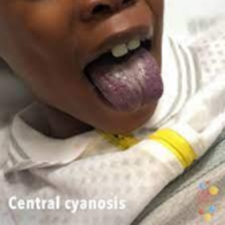A nurse is caring for a client who has COPD.
Nurses' Notes
Vital Signs
Medication
Home health nurse admission note:
Client discharged from healthcare facility yesterday following a 4-day stay for exacerbation of COPD. Lives alone; alert and oriented to person, place, and time. Lung fields with scattered rhonchi throughout, cough productive for thick white sputum, dyspnea with minimal exertion.
Clubbing is noted on fingers, chest is barrel-shaped. Supplemental oxygen at 2L/min via nasal cannula.
Home Health Nurse Note 3 days following discharge from health care facility: Client sleeping in recliner with nasal canula on their lap; awakens easily and is oriented to person but disoriented to place and time.
Lung sounds with scattered rhonchi, cough productive for thick, yellow secretions. 2+pitting edema bilateral in ankles and feet.
Re-oriented client. Client states "I don't remember if I did that breathing machine thing you told me about."
Instructed client on oxygen use, safety, and nebulizer treatments. Elevated lower extremities.
Select the 5 findings that require follow-up.
Disorientation
Barrel-shaped chest
Yellow sputum
Nebulizer use
Ankle edema SaO2 92% Clubbing of fingers
Lives alone
Correct Answer : A,C,D,E,F
- Disorientation may indicate hypoxia, infection, or medication side effects. - Yellow sputum may indicate a bacterial infection that requires antibiotics. - Nebulizer use may indicate that the client is not using it correctly or regularly as prescribed, which can affect their lung function and oxygenation. - Ankle edema may indicate fluid overload or heart failure, which can worsen COPD symptoms and increase the risk of complications.
- Living alone may pose safety risks for the client, especially if they are disoriented or have difficulty managing their oxygen and nebulizer treatments. The nurse should assess the client's support system and refer them to community resources if needed.
Nursing Test Bank
Naxlex Comprehensive Predictor Exams
Related Questions
Correct Answer is C
Explanation
This is because central cyanosis reflects a decrease in arterial oxygen saturation and is best seen in areas where blood vessels are close to the surface, such as the oral mucosa, tongue, and lips. Peripheral cyanosis, which may be caused by vasoconstriction or poor circulation, can be seen in the soles of the feet, ear lobes, and nail beds, but it does not necessarily indicate hypoxemia.

Correct Answer is A
Explanation
Eating a high fiber diet has not been proven to reduce the risk for developing skin cancer. Skin cancer is mainly caused by exposure to ultraviolet (UV) radiation from the sun or artificial sources, such as tanning booths.
Whether you are a student looking to ace your exams or a practicing nurse seeking to enhance your expertise , our nursing education contents will empower you with the confidence and competence to make a difference in the lives of patients and become a respected leader in the healthcare field.
Visit Naxlex, invest in your future and unlock endless possibilities with our unparalleled nursing education contents today
Report Wrong Answer on the Current Question
Do you disagree with the answer? If yes, what is your expected answer? Explain.
Kindly be descriptive with the issue you are facing.
